Seeking central Iowa’s ultimate BBQ
8/6/2025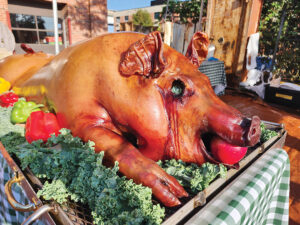
Whole hog BBQ, like this one from Webster City Custom Meats, is still practiced in Iowa.
Historically, Iowa has been barbecue challenged. Before refrigeration became common, the BBQ genre developed in the American South as the main method of preserving meat, seafood and poultry. In Iowa, ice was more expendable than hard wood, which was better used to heat homes. So, we built ice houses, and the South built smokehouses.
Because BBQ was a means to avoid waste, whole animal cooking dominated America’s original BBQ. Whole hog BBQ was so associated with southerners that the slang term “going whole hog” was coined by New Englander Daniel Webster in answer to a question about what he expected from a presidency of Tennessee’s Andrew Jackson. “Whole, low and slow”
Such cooking, with wood fuel, evolved into “barbecue” with regional distinctions. In the Carolina’s, Virginia and Georgia, it meant pork. West of there, a mix of pork and beef plus chicken, goats and lamb were used. In Texas, it was nearly all beef and wild game. Carolina was divided by preference for sauces. Eastern Carolina used a vinegar base sauce, western Carolina a tomato base and South Carolina a mustard base. Alabama developed a taste for chicken served with a white barbecue sauce.
All-wood smoking is the most characteristic thing about early BBQ. To this day, the surest sign of traditional BBQ is a wood pile. Jethro’s keeps piles of hickory for pork, oak for beef and cherry wood for hams.
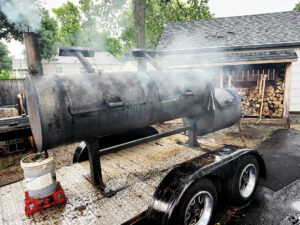
Wood piles, like this at Flying Mango, are the surest sign of traditional BBQ.
In the last 30 years, whole hog cooking has all but disappeared from restaurants, except in eastern North Carolina and two counties in west central Tennessee. All-wood cooking has been displaced in restaurants, too, by environmentally correct gas “smokers.” Wood cooking was even banned in former BBQ citadels like Raleigh and Durham as northern environmentalists moved south.
Still, several wood-burning joints thrived in the middle of the 20th century Des Moines. Canfield’s and Black’s had long lines of people at rush hours, but they didn’t outlive the 1960s. In the last quarter of the 20th century, barbecue in this state had become an endangered species.
Kin Folks was a legendary Iowa BBQ that took up most of downtown Attica — a pure wood-smoking joint that you could smell a mile away. It tried to expand to Des Moines, Altoona and Knoxville, but it never took hold and is now completely closed. Along with just a handful of other places like Al and Irene’s in Cedar Rapids, Claxon’s in Altoona, Hickory House in Ames, plus Big Daddy’s and Battle’s in Des Moines (which later moved to Ames), they kept the state’s smokehouse embers from completely burning out.
Things changed dramatically beginning in 2003 when Mike Wedeking opened Flying Mango, a pure wood-burning barbecue that quickly became a lifestyle statement to its fans, including a number of famous musicians (Lipbone Redding, Jonah Smith, Carrie Rodriguez, etc.) who play there out of love for the place though their reputations command much larger venues. Flying Mango is also known for smoking exotics like catfish, goose, duck, bison, lamb chops and elk. The restaurant appeared so many times on Food Channel’s “Diners, Drive-ins and Dives” that people from all over America journey there.
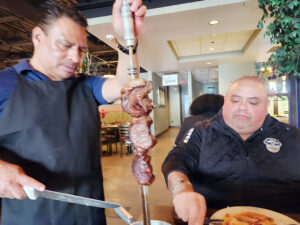
Brazilian churrascaria is a gaucho form of BBQ like this at Terra Grill.
Because BBQ abhors a vacuum, soon after Kin Folks closed, Whatcha Smokin’ took over most of downtown Luther with Texas-style BBQ that quickly became a bona fide tourist attraction. Parking lot license plates come from counties all over Iowa and neighboring states.
In the early part of the new century, barbecue was Food Dude’s “genre of the year” four out of five years running, meaning more new barbecues opened than any other type of restaurant. That reversed a 50-year down cycle. The surge in smoking was fueled by nostalgia, by the perfection of affordable gas “smoking” equipment, and by the competition circuit, which grew exponentially after World Pork Expo began holding barbecue cook-offs in Des Moines. Now, many towns in Iowa hold competitions.
Mason City Globe Gazette publisher and “Up In Smoke” festival director Howard Query explained how his town initiated their barbecue event.
“We wanted a premiere event to draw people here. I could see that competitive barbecue was an up-and-coming sport,” he said.
To understand barbecue as a “sport,” compare it to professional golf. Both have four major events: the Jack Daniels Invitational (The Masters); the Sam’s Club National Tour finals, formerly The American Royal (U.S. Open); Memphis in May (The Open); and the Houston Livestock & Rodeo BBQ (the PGA). Numerous others across the country allow competitors to qualify and prepare for the big four. Most Iowa events are geared for Sam’s Club and use its “Kansas City rules.”
What is BBQ?
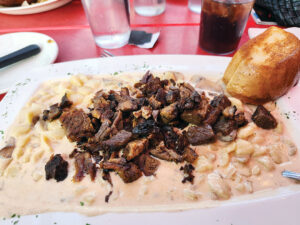
Hessen Haus uses smoked brisket in beef stroganoff.
Ah, barbecue. Millions love it and yet many of its fans argue, sometimes even fight, over what it is. Meathead Goldwyn, one of America’s great food writers and historians, attempted an answer on his website Amazingribs.com. In his “So what is barbecue?” article, he presented a definition that is 1,493 words long. That’s just for barbecue as a noun. His definition for its use as a verb ran more than 1,500 words.
By way of explaining how one word could be so complex, Goldwyn quoted Harvard linguist and evolutionary psychologist Steven Pinker: “People are under the impression that dictionaries legislate language. What a dictionary does is keep track of usages over time.”
Most likely, the first barbecue masters were ancient Chinese cooks. “Char siu” has been prepared much the same way since Confucius’ time when wild boars and other game were first marinated in five-spice powder, rice vinegar and red fermented tofu to produce its colorful ring when cooked over open fires. Today, it is usually cooked in ovens and made with pork shoulders, then served in buns or with rice or noodles. It is available at a dwindling number of places around the metro, but beautifully so at C Fresh Market.
Char siu has likely been around much longer than the kind of barbecue that Caribbean Indians were practicing when Chris Columbus first noted their “barbacoa.” That Taino word defined tall wooden stands built above open pit fires erected to dry, smoke and preserve fish, lizards, alligators, birds and small game.
That would give a name to the type of cooking that was developed in the southern United States, mostly by displaced Africans. Instead of placing food directly over the source of heat, whole animals were usually placed in deep pits where they were covered and slow cooked with indirect heat and smoke.

Flying Mango fries smoked catfish.
Today, all-wood slow cooking, the method that purists insist is the only true barbecue, is mostly preserved on the competition circuit. Yet, even there, two recent developments have deviated a long way from the traditional purism of “whole, low and slow” thinking. Many beef brisket competitors now buy Wagyu beef, from the breed of cow that spawned Kobe beef and demands top dollar for its superior marbling. The problem is that Wagyu marbling does not break down and melt correctly at the usual low temperatures (200-300 degrees F). So, they are being cooked at higher temperatures.
Also, thighs or hindquarters have replaced whole chickens as the preferred choice of competitors, and they are often cooked boneless and finished at high heat to give skin a crispness. Amara Sama only uses hindquarters in his jerk chicken at The Palms.
Des Moines is “Smoke Town”
Through most of the 20th century, barbecue was a specialty of the American South, distinguished regionally by the local woods: hickory in the Carolinas and the mountain states, burr oak in east Texas, mesquite in west Texas, and fruit woods in Georgia and Missouri.
Things changed with the new millennium. Southern barbecue lost its purity after Yankee environmentalists moved south and enacted wood-burning bans on once proud barbecue cities. In 1998, I asked the Chamber of Commerce president, who was also mayor of Lockhart, Texas, why almost all the best barbecues in his state were found in small towns like Llano, Luling, Taylor and Lockhart.
“Very simple, son. Big cities have too many encumbrances to good barbecue,” he replied.
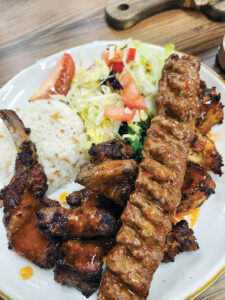
A mixed grill platter, like this from Istanbul Cafe, is also called BBQ, particularly the lamb skewers.
“Could you define what you mean by encumbrances?” I asked.
“They come in two main forms — health codes and safety codes. Even here in our town, some fresh-out-of-college bureaucrat proposed installing sprinklers over the pits. He didn’t last long,” the mayor laughed.
The shift away from pure wood-burning barbecue also inspired a boom for BBQ nostalgia. That manifested most notably in the burgeoning popularity of competitive barbecue, which adheres to the old, pure ways. Through much of the turn-of-the-century years, the barbecue cookoff at World Pork Expo in Des Moines was one of the more popular events on the competitive cycle. That brought the best southern smokers to central Iowa, where they competed with local guys who quickly learned that they could smoke with the very best.
Shad Kirton, owner of Kue’d in Waukee, won the largest prize in barbecue history on The Learning Channel’s “BBQ Pitmaster.” His former partner, Darren Warth, owner of Smoky D’s, has now won just about every major championship on the national circuit. Woody Wasson of the now closed Woody’s Smoke Shack in Des Moines also won a wall full of trophies.
BBQ has more accompaniments today. Smoky D’s comfort food menu draws long lines, and it is one of the only restaurants of any kind in Des Moines to hire a full-time pastry chef. Jethro’s side dishes developed in the kitchen of Splash, Iowa’s top fine dining seafood restaurant, with the same owner as Jethro’s — Bruce Gerleman. Cactus Bob’s includes homemade kettle chips among its side dishes and built its reputation with prickly pickles and smoked jerky. Whole smoked turkeys, bone-in hams and whole smoked prime ribs added to it.
Barbecue is moving into eclectic new applications in the metro. Tandoori chicken is being used in everything from salads to dosas at places like Amruth, Kathmandu, Lazaza and India Star. Hessen Haus uses BBQ in its beef stroganoff. Flying Mango creates catfish cakes by frying smoked catfish. Korean BBQ is popular in food truck tacos. Jerk chicken is used in tacos at The Palms. Flamed meat is served tableside at Terra Grill and Churrascaria. Skewers star at the Istanbul Café.
Jethro’s has garnered as much national praise and attention as any place with features on TV’s “Man vs. Food” and “Food Paradise,” by finishing runner-up out of 100 sandwiches in ESPN’s “National Fanwich” contest, by being named Men’s Health magazine’s “Manliest Sandwich in the Midwest,” and as Better Homes and Gardens’ favorite sandwich.
Before the death of owner Ike Seymour, Big Daddy’s made it onto both Peter Jennings’ “World News Tonight” and “The Early Show with Bryant Gumbel.” Woody’s Smoke Shack was named a top national barbecue by “Good Morning America.” Cactus Bob’s was featured on a national TV show about extreme eating.
Today, Des Moines is as big a barbecue town as any place. While Southern barbecue has been diminished by regulations and technology, central Iowa smokehouses have gained national repute while maintaining some purist orthodoxy. Today, in Des Moines, where there’s smoke, there’s a choir singing its praises.
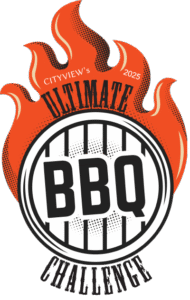 The Challenge
The Challenge
So, for this year’s Cityview Ultimate Barbecue Challenge, we are opening up the field to anything that anybody thinks is barbecue. Smoked fish, smoked cheese, smoked ice cream, and Indian tandoor (remarkably similar to Big Green Egg barbecues) are sometimes closer in spirit to traditional barbecue than a lot of BBQ joints are. Chinese barbecue, Korean barbecue, Hawaiian barbecue, Japanese barbecue, Australian “barbie,” Mexican barbecue — they all work just fine. So do dishes that might have been cooked indoors and been labeled barbecue because sauce was added. Such have been deemed barbecue since 1913, by no less an authority than the great cookbook pioneer Fannie Farmer.
Food is the new politics. Both subjects inspire intense loyalties that are usually only shared by members of the same tribe. Just as Zohran Mamdani fans can’t comprehend how anyone could support fully funded police forces, lovers of two soft tortilla carnitas taco fans can’t understand U-shaped ground beef tacos with American cheese. If anything, food arguments are more splintered than political ones. That’s probably because every human has a unique combination of 2,000 to 8,000 different “taste buds,” each of which can be more or less sensitive from one person’s tongue than another’s. Those different combinations are as distinctive as fingerprints, yet most people want others to enjoy eating the same things they like to eat. I know couples who broke up over food selections, and women who dumped boyfriends for not allowing them to eat off their plates.
At CITYVIEW, the First Amendment is our favorite. We love a good argument. We leave the complexity of political polling to Ann Selzer (who is also a font of food information). However, to determine a consensus about more intricate local tastes, we instigated the Ultimate Food Challenge in 2010. This year, we seek the ultimate BBQ. Voting results and rules will be posted regularly on our web page and in this magazine. If you care about BBQ, it is your culinary duty to vote. http://ultimatefoodchallenge.dmcityview.com. ♦















